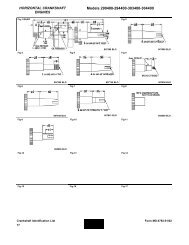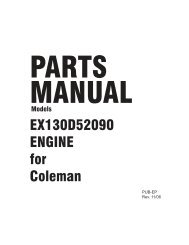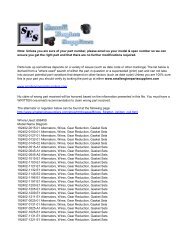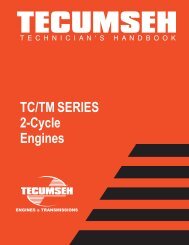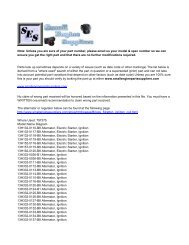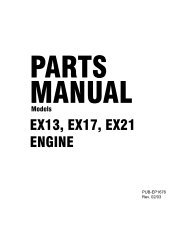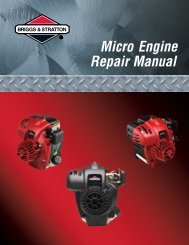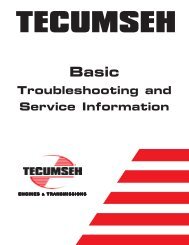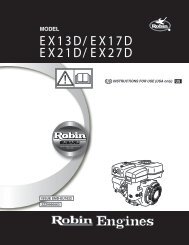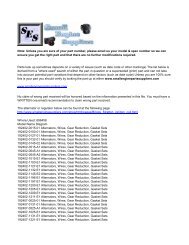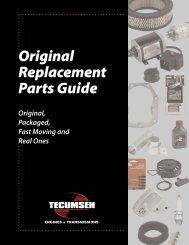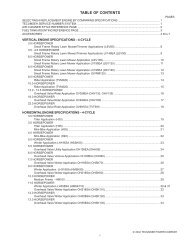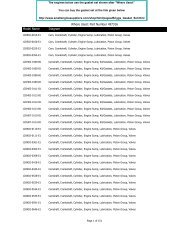3to 11hp 4-cycle l-head engines - Small Engine Suppliers
3to 11hp 4-cycle l-head engines - Small Engine Suppliers
3to 11hp 4-cycle l-head engines - Small Engine Suppliers
You also want an ePaper? Increase the reach of your titles
YUMPU automatically turns print PDFs into web optimized ePapers that Google loves.
TESTING PROCEDURE<br />
1. Check for spark using a commercially available spark<br />
tester and following the tester's recommended<br />
procedure.<br />
2. Check for the correct spark plug and for cracks in the<br />
porcelain, pitted or burned electrodes, excessive<br />
carbon buildup, and proper air gap setting. Replace<br />
if questionable.<br />
3. Remove the blower housing, disconnect the ignition<br />
ground lead at the ignition coil (solid state only).<br />
Reinstall the blower housing and crank the engine<br />
over. If spark occurs, check the ignition switch, safety<br />
interlock switches, electrical wiring for shorting to<br />
ground, or oil shutdown switch.<br />
NOTE: STANDARD POINT IGNITION MAY HAVE TO BE<br />
DISCONNECTED AT THE IGNITION SHUTOFF (AT THE<br />
SPEED CONTROL).<br />
4. Check the air gap between the flywheel magnets and<br />
the laminations of an externally mounted coil or<br />
module. It should be .0125 (.317 mm) or use gauge<br />
part # 670297.<br />
5. Check the flywheel magnets for the proper strength<br />
using this rough test. Hold a screwdriver at the<br />
extreme end of the handle with the blade down, move<br />
the blade to within 3/4 inch (19.05 mm) of the<br />
magnets. If the screwdriver blade is attracted to the<br />
magnets, the magnetic strength is satisfactory (diag.<br />
16).<br />
6. Examine the stator components (diag. 17).<br />
A. Check the ignition cam for roughness.<br />
B. Check the movable point arm that rests on the<br />
ignition cam for wear.<br />
C. Check the spring steel on the point assembly for<br />
evidence of excessive heat.<br />
D. Check contact points for wear. If they are pitted or<br />
burned, this is an indication that the condenser is<br />
not functioning properly. If any of the above are<br />
faulty, replace accordingly.<br />
E. When replacing the points, also replace the<br />
condenser.<br />
F. After the points are replaced and engine is retimed,<br />
be sure to clean the points with lint free<br />
paper. An engine will not run smoothly if the points<br />
are improperly set or coated with even a small<br />
quantity of oil, etc.<br />
3/4 " (19.05 mm)<br />
MAGNETS<br />
7. Examine the coil and lamination assembly (either internal or external) for cracks in the insulation or other damage<br />
which would cause shorts or leakage of current. Make sure the electrical leads are intact, especially where they<br />
enter the coil (diag. 18).<br />
8. Check the operation of the coil using an approved tester. Follow the instructions furnished with the test unit or<br />
booklets offered by the Tecumseh Products Co. <strong>Engine</strong> and Transmission Group Service Division. If the coil or<br />
lamination assembly is defective, replace as necessary.<br />
NOTE: IF LAMINATIONS ARE BAD ON AN INTERNAL COIL ASSEMBLY, THE ENTIRE STATOR BODY MUST BE<br />
REPLACED SINCE THE LAMINATIONS ARE PERMANENTLY RIVETED TO THE STATOR.<br />
External coils are permanently attached to the lamination and must be serviced as an assembly.<br />
16<br />
17<br />
18<br />
67



